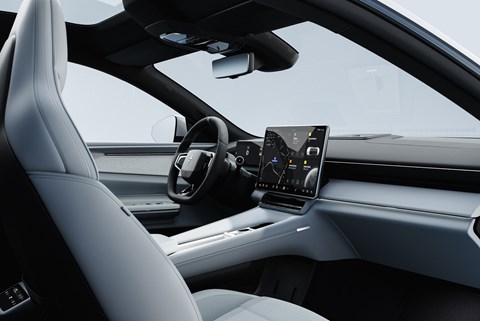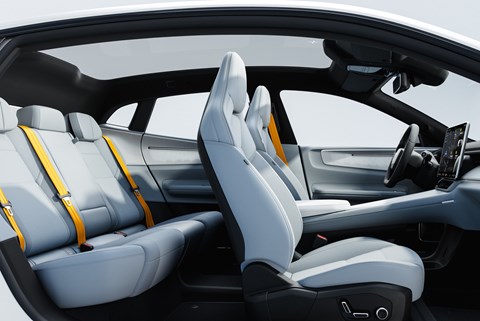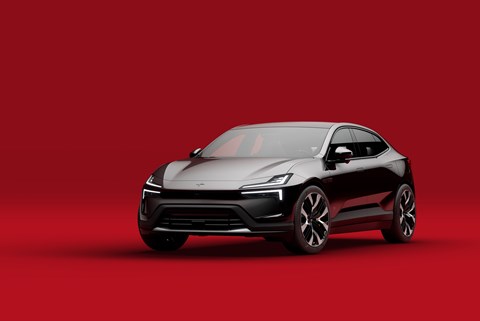► Polestar 4 is the quickest – and lowest-carbon – yet
► Up to 379 miles range and 536bhp
► Priced from around £60,000
Polestar claims its svelte new 4 EV is its cleanest model yet, with the brand’s own testing revealing that the 4 will produce 19.4 tonnes of CO2 over its lifetime, including production. Ironically, it’s also the fastest flavour of Polestar and will go head-to-head with the new Porsche Macan Electric and Tesla Model Y.
What exactly is the Polestar 4?
Rather than just start with an SUV then replace the sensible square roofline with something more rakish, the Polestar 4 is a purpose-built Coupé that just so happens to sit a bit taller. And a bit taller is the right choice of words; the 4 shaves almost 8cm from the height of the Porsche Macan that it has firmly in its sights.

This clean sheet approach has led to some interesting decisions being made, the most notable of which is the removal of the rear screen.
Wait, what?
That’s right, the tailgate has no window on it at all with the view taken care of by a wide-angle camera rear-view mirror (the door mirrors remain conventional). Parents with hyperactive children need not worry, a press of a button turns it into a regular mirror should you need to investigate any suspicious silences.

Any concerns that the interior now resembles a coal scuttle with the reduced window count evaporate as soon as you step inside. All Polestar 4s get a massive panoramic roof that floods the cabin with light, with electrochromic elements optional should you want to block things out.
Rear occupants get their own touchscreen to adjust the climate control and other functions, whilst the back seats recline electrically using buttons cunningly hidden on the side of the arm rest. Space is sufficient for a couple of 6’ 2” adults to be comfortable behind similarly tall drivers.
So, it’s practical then?
Yes, although you’ll still need a conventional SUV or estate for maximum load lugging ability. Boot space below the parcel shelf is a decent 526 litres, but that roofline limits seats down space to 1536 litres, good but not exceptional.
Move forward and you’ll find plenty of oddment storage on the two-level centre console but no glovebox or frunk for that matter.
What about the business end?
Unlike other Polestars, the 4 has its Android Automotive-based 15.4-inch infotainment system in a landscape orientation. That’s not an admission that other models are wrong, but merely to give the 4’s cockpit a wider, sportier feel.

There’s also a 10.2-inch digital driver’s display and a 14.7-inch head up display to help relay information as clearly as possible. A sign of the car’s Swedish roots is a snow mode for the HUD that switches white text to yellow. Clever.
We’re big fans of the Polestar 4’s interior ambiance, and that’s without seeing the new colour changing ambient lighting that’s inspired by the solar system. The different modes even come with some educational stuff for your kids, so they can learn about Mars, for instance.

While we can’t speak about build quality until we’ve seen a finished production car, early signs are very promising. There are plenty of sustainable materials, but you’re not necessarily aware they’re there. Instead, the materials used feel at least as plush as a Porsche Macan Electric or BMW iX3 to give the Polestar 4 a very inviting interior.
Tell me about the mechanicals, then
The 4’s SEA platform is provided by parent company Geely but will be thoroughly reworked by Polestar including some fettling in the UK. A chunky 102kWh battery pack is standard, giving a potential maximum range for the rear-wheel drive model of 379 miles. Impressively, the dual motor model with twice as much power should be good for 360 miles.
Entry-level single motor cars get 268bhp and 253Ib ft of torque, enough for 0-62mph in 7.1 seconds and a 124mph top speed. The dual motor does a far better job of motivating this 2.3-tonne SUV. With power up to 536bhp and torque to 506Ib ft, 0-62mph is dispatched in a mere 3.8 seconds, or faster even than the more powerful Polestar 1.

Single motor models get passive dampers, with the dual motor gaining ‘semi-active dampers’ for a sharper handling. Like the Polestar 2, a Performance Pack is available for the dual motor which adds four-piston Brembo brakes, bespoke chassis tuning, forged 22-inch wheels and Swedish gold detailing on the brakes, seatbelts and tyre’s valve caps.
And charging?
All versions get up to 200kW DC and 22kW AC charging capability accessed via a fancy motorised charging door. It takes just 30 minutes to get from 10-80% charged using a 200kW DC charger, while 0-100% takes five and a half hours on a three-phase 22kW wallbox. A typical 7.4kW wallbox will take over twice as long to top up.